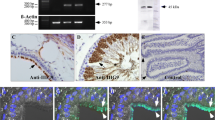Summary
To confirm the possibility that protein kinase C is involved in compaction of mouse embryos, the presence and distribution pattern of Ca2+-dependent subspecies of this enzyme in mouse embryos, before and during compaction, were examined immunocytochemically with three different monoclonal antibodies. These were MC-1a, MC-2a and MC-3a, which selectively interact with the subspecies of the enzyme known as types I, II and III, respectively. Only when embryos were incubated with MC-3a, was immunofluorescence clearly detected in all cells of embryos before and during compaction. This result demonstrates the presence of type III protein kinase C in embryos before and during compaction and suggests the possibility that the type III enzyme may be involved in compaction. No marked differences were found in the distribution pattern of the type III enzyme between embryos examined before and during compaction.
Similar content being viewed by others
References
BACHVAROVA, R. & DDE LEON, V. (1980) Polyadenylated RNA of mouse ova and loss of maternal RNA in early development. Dev. Biol. 74, 1–8.
EMERSON, J. A. (1988) Disruption of the cytokeratin filament network in the preimplantation mouse embryo. Development 104, 219–34.
HIDAKA, H., TANAKA, T., ONODA, K., HAGIWARA, M., WATANABE, M., OHTA, H., ITO, Y., TSURUDOME, M. & YOSHIDA, T. (1988) Cell type-specific expression of protein kinase C isozymes in the rabbit cerebellum. J. Biol. Chem. 263, 4523–6.
HUANG, K.-P., NAKABAYASHI, H. & HUANG, F. L. (1986) Isozymic forms of rat brain Ca2+-activated and phospholipid-dependent protein kinase. Proc. Natl Acad. Sci. USA 83, 8535–9.
HUANG, F. L., YOSHIDA, Y., NAKABAYASHI, H. & HUANG, K.-P. (1987) Differential distribution of protein kinase C isozymes in the various regions of brain. J. Biol. Chem. 262, 714–20.
JAKEN, S. & KILEY, S. C. (1987) Purification and characterization of three types of protein kinase C from rabbit brain cytosol. Proc. Natl Acad. Sci. USA 84, 4418–22.
KIKKAWA, U., ONO, Y., OGITA, K., FUJII, T., ASAOKA, Y., SEKIGUCHI, K., KOSAKA, Y., IGARASHI, K. & NISHIZUKA, Y. (1987) Identification of the structures of multiple subspecies of protein kinase C expressed in rat brain. FEBS Lett. 217, 227–31.
LEHTONEN, E. & BADLEY, R. A. (1980) Localization of cytoskeletal proteins in preimplantation mouse embryos. J. Embryol. Exp. Morph. 55, 211–25.
NISHIZUKA, Y. (1984) The role of protein kinase C in cell surface signal transduction and tumour promotion. Nature 308, 693–8.
NISHIZUKA, Y. (1988) The molecular heterogeneity of protein kinase C and its implications for cellular regulation. Nature 334, 661–5.
NISHIZUKA, Y. (1992) Intracellular signaling by hydrolysis of phospholipids and activation of protein kinase C. Science 258, 607–14.
OHSUGI, M., OHSAWA, T. & SEMBA, R. (1993a) Similar responses to pharmacological agents of 1,2-OAG-induced compaction-like adhesion of two-cell mouse embryo to physiological compaction. J. Exp. Zool. 265, 604–8.
OHSUGI, M., OHSAWA, T. & YAMAMURA, H. (1993b) Involvement of protein kinase C in nuclear migration during compaction and the mechanism of the migration: analyses in two-cell mouse embryos. Dev. Biol. 156, 146–54.
OHTA, H. (1990) Possible involvement of protein kinase C in early development of the mouse. Mie Igaku 34, 79–86 (in Japanese).
PAYNTON, B. V., REMPEL, R. & BACHVAROVA, R. (1988) Changes in state of adenylation and time course of degradation of maternal mRNAs during oocyte maturation and early embryonic development in the mouse. Dev. Biol. 129, 304–14.
SPINDLE, A., NAGANO, H. & PEDERSEN, R. A. (1985) Inhibition of DNA replication in preimplantation mouse embryos by aphidicolin. J. Exp. Zool. 235, 289–95.
VESTWEBER, D., GOSSLER, A., BOLLER, K. & KEMLER, R. (1987) Expression and distribution of cell adhesion molecule uvomorulin in mouse preimplantation embryos. Dev. Biol. 124, 451–6.
WINKEL, G. K., FERGUSON, J. E., TAKEICHI, M. & NUCCITELLI, R. (1990) Activation of protein kinase C triggers premature compaction in the four-cell stage mouse embryo. Dev. Biol. 138, 1–15.
YAMAMURA, H. & SPINDLE, A. (1988) Stage-specific response of preimplantation mouse embryos to W-7, a calmodulin antagonist. J. Exp. Zool. 248, 45–54.
Author information
Authors and Affiliations
Rights and permissions
About this article
Cite this article
Ohsugi, M., Yamamura, H., Semba, R. et al. Immunocytochemical detection of Ca2+-dependent subspecies of protein kinase C in mouse embryos before and during compaction. Histochem J 26, 641–643 (1994). https://doi.org/10.1007/BF00158288
Received:
Revised:
Issue Date:
DOI: https://doi.org/10.1007/BF00158288




